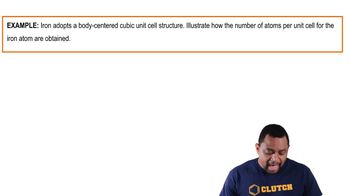Here are the essential concepts you must grasp in order to answer the question correctly.
Density and its Calculation
Density is defined as mass per unit volume, typically expressed in grams per cubic centimeter (g/cm³). To find the radius of an atom from density, one must relate the mass of the unit cell to its volume. The density formula can be rearranged to find the volume, which is essential for determining the dimensions of the unit cell.
Recommended video:
Body-Centered Cubic (BCC) Structure
A body-centered cubic (BCC) unit cell is a type of crystal lattice structure where one atom is located at each corner of the cube and one atom is at the center. In a BCC structure, the relationship between the edge length (a) and the atomic radius (r) is given by the formula: a = 4r/√3. Understanding this relationship is crucial for calculating the radius of the sodium atom.
Recommended video:
Body Centered Cubic Example
Unit Cell Volume and Atomic Radius
The volume of a unit cell can be calculated using the edge length (a) of the cube, where volume = a³. For a BCC unit cell, knowing the density allows us to find the mass of the unit cell, which can then be used to derive the edge length and subsequently the atomic radius. This process is fundamental in solid-state chemistry for determining atomic dimensions.
Recommended video:
 Verified step by step guidance
Verified step by step guidance


